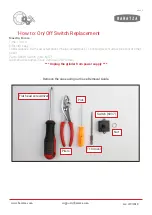
RG74T-R Operator · Service · Maintenance
800.392.2686
19
Safety
LOCK-Out / Tag-Out Guidelines
Always practice lock out tag out procedures when working
on this machine.
Locking and tagging out equipment safeguards those working
on the equipment from being injured by its unexpected
energy or releasing stored energy. This section summarizes
the applicable requirements for lockout/ tag out procedures,
and its intent to comply with OSHA regulations.
Lock Out Procedure
• All affected persons are to be notified that the equipment
will be off and locked out.
• All energy sources for the equipment should be identified.
• The equipment shall be shut off or otherwise de-
energized, being careful to de-energize all energy
sources. This includes all valves, switches, breakers, or
other controls that supplies energy to the equipment.
In case of mechanical energy, a block may be used to
stop the release of stored energy.
• A lock is to be placed on each energy source disconnect
or energy release block.
1. The lock is to be placed directly on the equipment if
provided with an integral locking device.
2. If there is no integral lockout device on the equipment,
securely attach an independently manufactured lockout
device on the equipment and then place the lock on the
lockout device.
3. If none of the above are possible, use the tag out
procedure.
• A tag to be secured to the lock indicating that the
equipment is not to be energized and who owns the lock.
• It should be safely tested and verified that the lockout
does prevent the release of energy.
Tag Out Procedure
• This procedure is to be used only if it is not reasonable
to use the lockout procedure.
• All affected persons are to be notified that the equipment
will be shut off and tagged out.
• All energy sources for the equipment should be identified.
• The equipment shall be shut off or otherwise de-
energized, being careful to de-energize all energy
sources. This includes all valves, switches, breakers, or
other controls that supplies energy to the equipment.
in case of mechanical energy, a block may be used to
stop the release of stored energy.
• Securely place a tag on each energy source disconnect
or energy release block.
Before the removal of a lockout/tag out
the following must be completed:
1. Removal of all non essential items.
2. Check to see that all workers and bystanders are
located in a safe position.
3. Inform all affected personnel.
• If a worker who applied the lockout/tag out is not present,
and his supervisor deems it necessary to energize the
equipment, the following must be done by the supervisor.
1. Make all reasonable effort to contact the worker who
placed the tag.
2. Determine the purpose of the lockout/tag out, and
whether it is safe to operate the equipment in its current
condition.
3. Remove all non essential items.
4. Inform all affected personnel.
5. Check to see that all affected persons are located in
a safe position.
6. Inform the worker of the lockout/tag out removal before
the worker starts to work for his/her next shift.
7. When more than one person works on the same
equipment, multiple lock/tag outs must be used. Only
when all locks are removed can the equipment be
energized.
Removal Procedure
• Lockout/tag out equipment must be removed by the
worker who placed it.
Parking
Park on a level surface. If you must park on a grade, chock
the machine.
1. Move the joystick control slowly to the NEUTRAL position
in order to stop the machine.
2. Move the throttle control lever to the LOW IDLE position.
3. Lower all implements (if equipped) so that the work tool
implement rests firmly on the ground.
4. Move the hydraulic controls to the NEUTRAL position.
5. Turn the engine start switch key to OFF position and
remove the key.
6. Disconnect the operator restraint devices (if equipped)
and exit the machine.
While Servicing and Performing
Maintenance on the Machine
• ALWAYS Block the wheels to prevent unintended
movement.
• Adhere to your LOCK-OUT/TAG-OUT procedure when
performing maintenance or repairs to this machine.
Locking and tagging out equipment safeguards
those working on equipment from being injured by its
unexpected energized or releasing stored energy.
Summary of Contents for RG74T-R
Page 23: ...RG74T R Operator Service Maintenance 800 392 2686 23 Safety ...
Page 24: ...RG74T R Operator Service Maintenance 24 Operation 3 5 6 8 1 4 11 2 7 4 9 10 12 13 ...
Page 35: ...RG74T R Operator Service Maintenance 800 392 2686 35 Operation ...
Page 55: ...RG74T R Operator Service Maintenance 800 392 2686 55 Main Wiring Harness 35170 G ...
Page 58: ...RG74T R Operator Service Maintenance 58 Hydraulic Schematic 805039 ...
















































